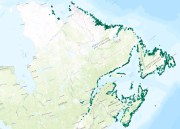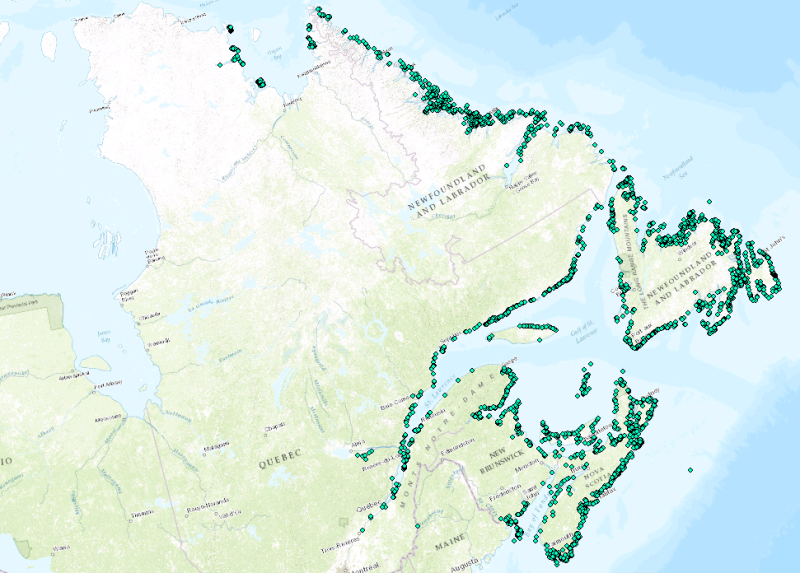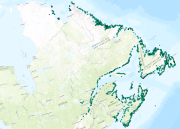Atlantic Colonies - Density Analysis
Data Sources: Banque informatisée des oiseaux de mer au Québec (BIOMQ: ECCC-CWS Quebec Region) Atlantic Colonial Waterbird Database (ACWD: ECCC-CWS Atlantic Region)..
Both the BIOMQ and ACWD contain records of individual colony counts, by species, for known colonies located in Eastern Canada. Although some colonies are censused annually, most are visited much less frequently. Methods used to derive colony population estimates vary markedly among colonies and among species. For example, census methods devised for burrow-nesting alcids typically rely on ground survey techniques. As such, they tend to be restricted to relatively few colonies. In contrast, censuses of large gull or tern colonies, which are geographically widespread, more appropriately rely on a combination of broad-scale aerial surveys, and ground surveys at a subset of these colonies. In some instances, ground surveys of certain species are not available throughout the study area. In such cases, consideration of other sources, including aerial surveys, may be appropriate. For example,data stemming from a 2006 aerial survey of Common Eiders during nesting, conducted by ECCC-CWS in Labrador, though not yet incorporated in the ACWD, were used in this report. It is important to note that colony data for some species, such as herons, are not well represented in these ECCC-CWS databases at present.
Analysis of ACWD and BIOMQ data (ECCC-CWS Quebec and Atlantic Regions): Data were merged as temporal coverage, survey methods and geospatial information were comparable. Only in cases where total counts of individuals were not explicitly presented was it necessary to calculate proxies of total counts of breeding individuals (e.g., by doubling numbers of breeding pairs or of active nests). Though these approaches may underestimate the true number of total individuals associated with a given site by failing to include some proportion of the non-breeding population (i.e., visiting adult non-breeders, sub-adults and failed breeders), tracking numbers of breeding individuals (or pairs) is considered to be the primary focus of these colony monitoring programs.In order to represent the potential number of individuals of a given species that realistically could be and may historically have been present at a given colony location (see section 1.1), the maximum total count obtained per species per site since 1960 was used in the analyses. In the case of certain species,especially coastal piscivores (Wires et al. 2001; Cotter et al. 2012), maxima reached in the 1970s or 1980s likely resulted from considerable anthropogenic sources of food, and these levels may never be seen again. The effect may have been more pronounced in certain geographic areas. Certain sites once used as colonies may no longer be suitable for breeding due to natural and/or human causes, but others similarly may become suitable and thus merit consideration in long-term habitat conservation planning. A colony importance index (CII) was derived by dividing the latter maximum total count by the potential total Eastern Canadian breeding population of that species (the sum of maximum total counts within a species, across all known colony sites in Eastern Canada). The CII approximates the proportion of the total potential Eastern Canadian breeding population (sum of maxima) reached at each colony location and allowed for an objective comparison among colonies both within and across species. In some less-frequently visited colonies, birds (cormorants, gulls, murres and terns, in particular) were not identified to species. Due to potential biases and issues pertaining to inclusion of these data, they were not considered when calculating species’ maximum counts by colony for the CII. The IBA approach whereby maximum colony counts are divided by the size of the corresponding actual estimated population for each species (see Table 3.1.2; approximate 1% continental threshold presented) was not used because in some instances individuals were not identified to species at some sites, or population estimates were unavailable.Use of both maxima and proportions of populations (or an index thereof) presents contrasting, but complementary, approaches to identifying important colonial congregations. By examining results derived from both approaches, attention can be directed at areas that not only host large numbers of individuals, but also important proportions of populations. This dual approach avoids attributing disproportionate attention to species that by their very nature occur in very large colonies (e.g., Leach’s Storm Petrel) or conversely to colonies that host important large proportions of less-abundant species (Roseate Tern, Caspian Tern, Black-Headed Gull, etc.), but in smaller overall numbers.
Point Density Analysis (ArcGIS Spatial Analyst) with kernel estimation, and a 10-km search radius,was used to generate maps illustrating the density of colony measures (i.e., maximum count by species,CII by species), modelled as a continuous field (Gatrell et al. 1996). Actual colony locations were subsequently overlaid on the resulting cluster map. Sites not identified as important should not be assumed to be unimportant.
Basic view
Metadata Record Information
- File Identifier
- 87bf8597-4be4-4ec2-9ee3-797f5eafbd97 XML
- Date Stamp
- 2025-02-03T15:16:47.748Z
- Metadata language
-
eng; CAN
- Character set
- UTF8
- Hierarchy Level
- Series
http://ec.gc.ca
Data identification
- Title
-
Atlantic Colonies - Density Analysis
- Date (Publication)
- 2016-01-14
- Date (Creation)
- 2014-09-01
- Status
- Completed
- Metadata language
-
eng; CAN
- Character set
- UTF8
- Topic category
-
- Biota
- Environment
- Biota
- Maintenance and Update Frequency
- Not planned
- Spatial representation type
- Vector
Keywords
- Place
-
-
Eastern Canada, Atlantic Ocean
-
- Theme
-
-
Bird Colonies, Seabirds
-
-
Government of Canada Core Subject Thesaurus
-
-
Birds
-
-
ECCC Information Category EN
-
-
Nature and Biodiversity
-
-
Business Functions
-
-
Protect Species Well-Being
-
Assess Status of Species
-
-
Geography
-
-
Atlantic - Prince Edward Island (PE)
-
-
external.theme.EC_Branch
-
-
Environmental Stewardship Branch
-
-
external.theme.EC_Directorate
-
-
Canadian Wildlife Service
-
-
external.theme.GC_Security_Level
-
-
Unclassified
-
- Use Limitation
-
Open Government Licence - Canada ( http://open.canada.ca/en/open-government-licence-canada)
- Access Constraints
- License
- Use Constraints
- License
- Begin Date
- 1841-01-01
- End Date
- 2013-09-01
Extent
))
Ref. system Reference Systems
- Reference system identifier
- EPSG / EPSG:4326 / 7.11.2
Distribution
Distribution Formats
- Distribution format
-
- SHP ( 10.1)
http://ec.gc.ca
Overviews




))
Provided by
